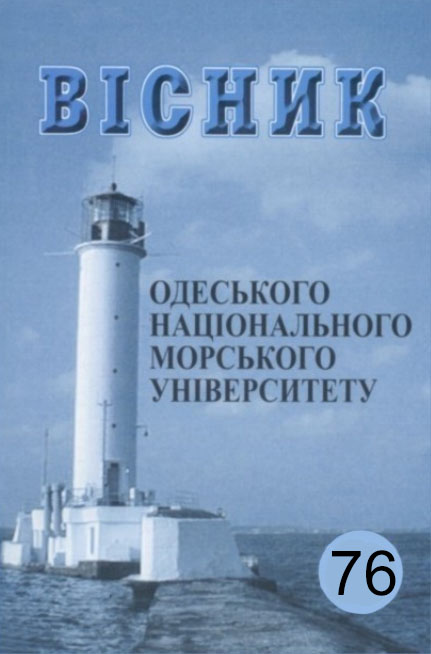Influence of thrusters on the electric ships’ maneuvering characteristics during their circulation run
Main Article Content
Abstract
The purpose of the study is to develop a method for assessing the influence of thrusters on the electric ships’ controllability indicators when entering circulation. When performing maneuvering operations, all components of the electric ships’ propulsion systems continuously operate in transient modes. The analysis of maneuvering properties in such conditions should be carried out considering the joint operation of all components of a ship’s propulsion system. The indicators of the Maneuverability Standard and the quality indicators of the functioning of the ship's electric power plant were chosen as the quality criteria. The calculation of the thrusters’ operating modes is based on an analytical method that allows estimating the thrust and resistance moment of the propellers in transient modes, taking into account the hydrodynamic processes of their interaction with the ship's hull. A method for assessing the maneuvering characteristics of propulsion systems has been developed, taking into consideration the loads on their electric power plants. The degree of influence of the ship's speed on maneuverability indicators when entering a curvilinear trajectory has been revealed. It is shown that the significant influence of thrusters on maneuvering characteristics is manifested at low speeds. The loads on the ship's electrical power system do not exceed the permissible limits. The calculation method makes it possible to evaluate the electric ships’ maneuverability indicators and the quality indicators of their electrical power plants. It becomes possible to predict maneuvering properties of ships’ propulsion complexes with thrusters. Applied programs and research results open up opportunities for optimizing the control of electrical power plants.
Article Details
References
2. Yukun Feng, Zuogang Chen, Yi Dai, Ping Wang. (2020). An experimental and numerical investigation on hydrodynamic characteristics of the bow thruster. Ocean Engineering, 2020, vol. 209(8):107348. doi: 10.1016/j.oceaneng.2020.107348.
3. Teresa Abramowicz-Gerigk, Miroslaw K. Gerigk. (2020). Experimental study on the selected aspects of bow thruster generated flow field at ship zero-speed conditions. Ocean Engineering, 2020, vol. 209(92):107463. doi: 10.1016/j.oceaneng.2020.107463.
4. Liu Hui, Feng Yukun, Chen Zuogang, Dai Yi, Tian Ximin. (2017). Nume- rical Study of Pressure Fluctuation for Bow Thruster. Journal of Shanghai Jiaotong University , vol. 51(3), Р. 294-299. doi: 10.16183/j.cnki.jsjtu.2017.03.007.
5. Ionut Cristian Scurtu, Valentin Oncica. (2018). Combined CFX and Structural Simulation for Bow Thrusters Loading under Operating Condi- tions. Journal of Physics Conference Series, vol. 1122(1):012024. doi: 10.1088/1742-6596/1122/1/012024.
6. Kupraty O. (2021). Mathematical modelling of construction of ship turning trajectory using autonomous bow thruster work and research of bow thruster control specifics. Scientific Journal of Gdynia Maritime University, No. 118, June 2021, Р. 7-23. doi: 10.26408/118.01.
7. Ruth E. Propulsion Control and Thrust Allocation on Marine Vessels. Ph.D. Thesis, NTNU Norwegian University of Science and Technology, Trond- heim, Norway, 2008.
8. Yarovenko V.A., & Chernikov P.S. (2017). A calculation method of tran- sient modes of electric ships’ propelling electric plants. Electrical Engine- ering & Electromechanics, (6), Р. 32-41. https://doi.org/10.20998/2074-272X.2017.6.05 [in Ukrainian].
9. Yarovenko V.A., Chernikov P.S., Zaritskaya E.I., & Schumylo A.N. (2020). Control of electric ships’ propulsion motors when moving on curvilinear trajectory. Electrical Engineering & Electromechanics, (5), Р. 58-65. https://doi.org/10.20998/2074-272X.2020.5.09 [in Ukrainian].
10. Yarovenko V.O., Chernicov H.S., Schumylo J.M., Zarinska O.I. (2022). Mathematical model of transient modes of electric ships’ propulsion complexes with thrusters. Transport Development – Odesa, ONMU, 2022 –№ 3(14). С.110-129. DOI https://doi.org/10.33082/td.2022.3-14.09 .
11. Yarovenko V.A. (2020). Dynamics of propelling telectric power plants of electric ships’ propulsive complexes Development of Scientific Schols of Odessa National Maritime University: collective monograph. Riga: Izdevnieciba «Baltija Publishing». 2020. 500 p. https://doi.org/10.30525/978-9934-588-86-0.08
12. Schumylo J.M., Yarovenko V.O., Zarinska O.I. (2022). Dynamic similarity of electric ships’ propulsive complexes. Transport Development – Odesa, ONMU, 2022 – № 4 (15). С. 43-57. DOI https://doi.org/10.33082/td.2022.4-15.05 [in Ukrainian].
13. Oleksandr Shumylo, Volodymyr Yarovenko, Mykola Malaksianj, Oleksiy Melnyk (2023). Comprehensive Assessment of Hull Geometry Influence of a Modernized Ship on Maneuvering Performance and Propulsion System Parameters, Scientific Journal of Maritime Research (Pomorstvo), Vol 37 (2023) Р. 314-325. https://www.pfri.uniri.hr/web/en/dokumenti/pomorstvo/2023/12/13_768-Shumylo.et.al.pdf . [in Ukrainian].
14. Shumylo O., Yarovenko V., Malaksiano M., Melnyk O., & Iovchev S. (2025). Methods for assessing electric ships’ maneuvering and safety indicators based on the theory of the dynamic similarity. In Studies in Sys- tems, Decision and Control (Vol. 580, Р. 235-255). Springer. https://doi.org/10.1007/978-3-031-82027-4_15 [in Ukrainian].
